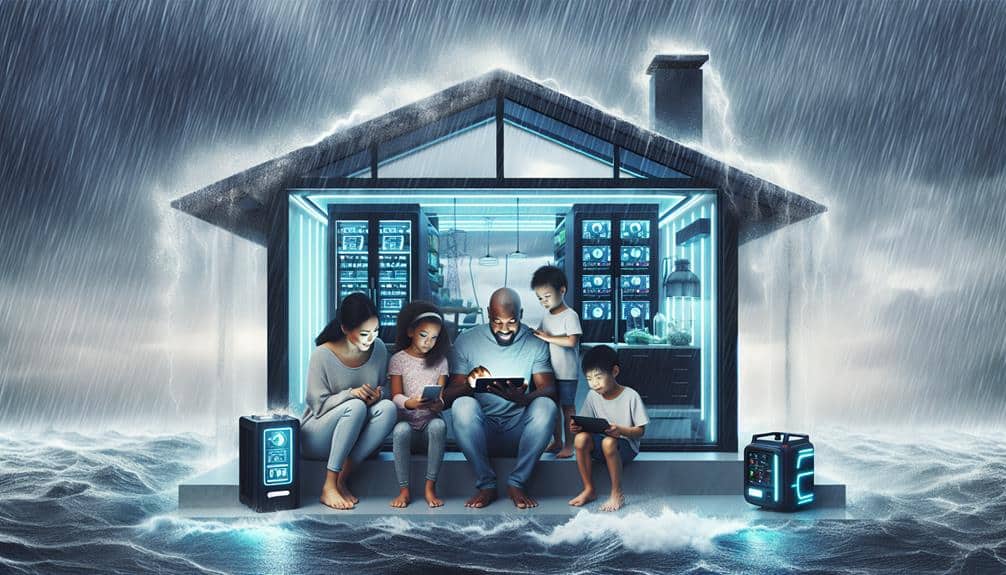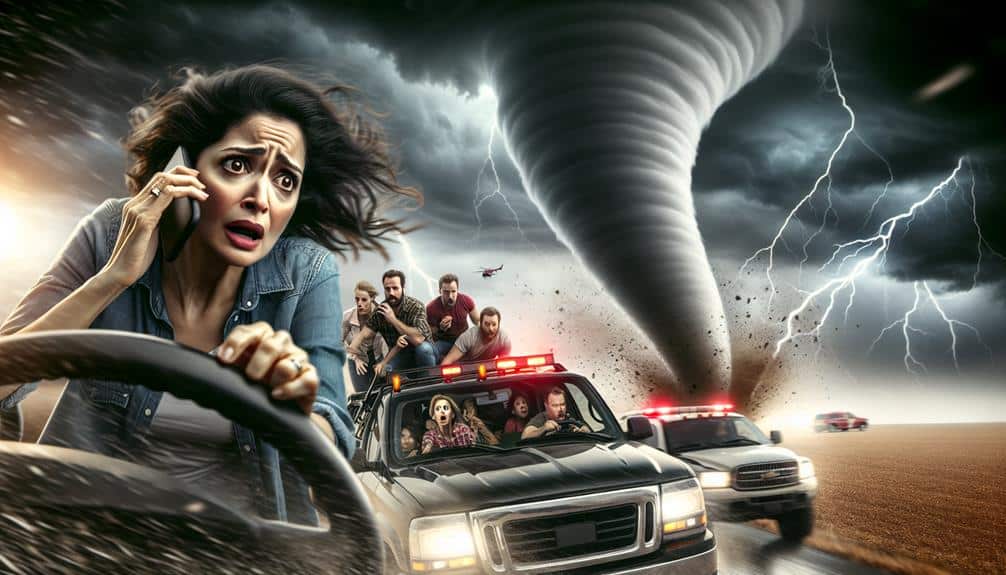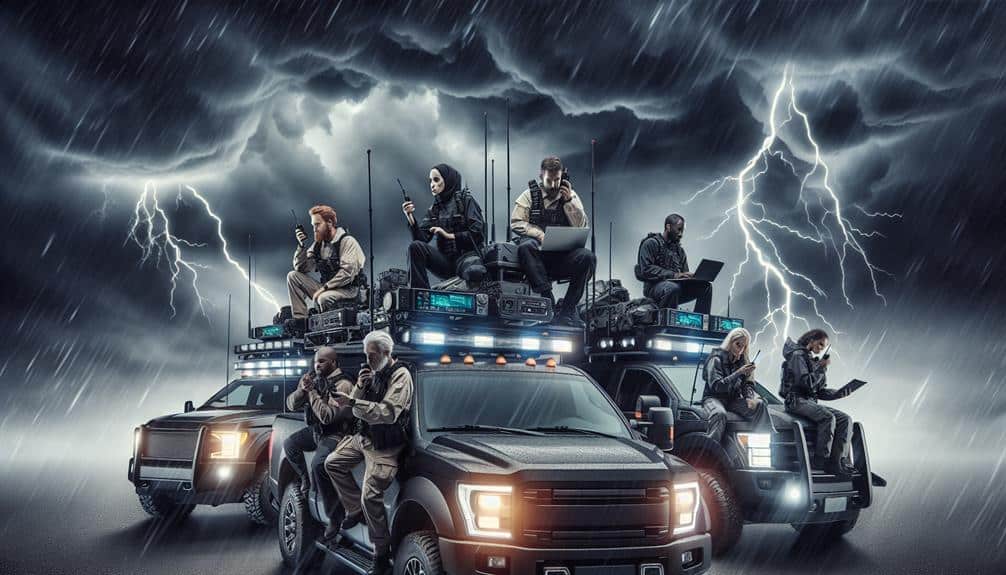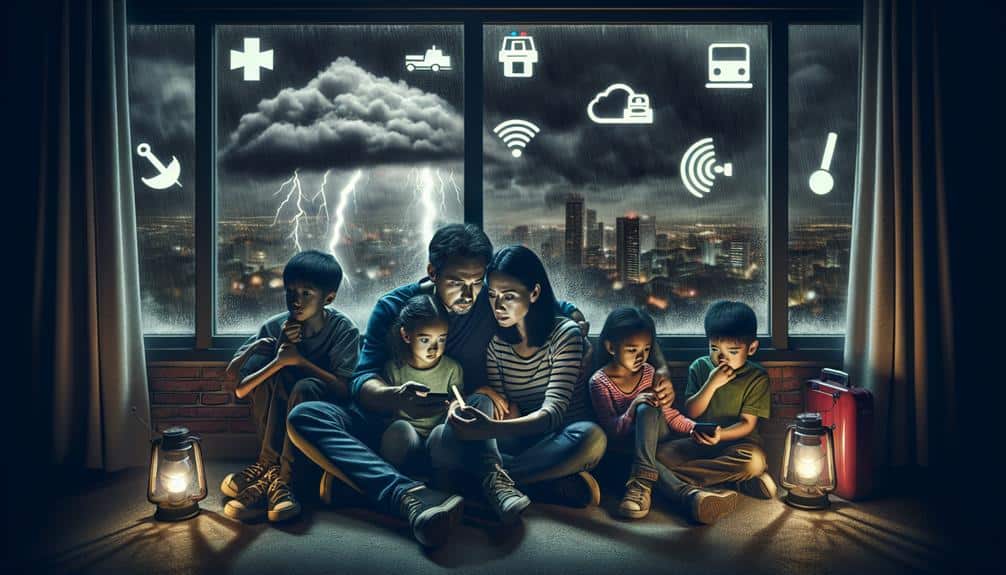When facing storms, we must use technology to communicate with emergency services efficiently. Real-time updates and GPS-driven location sharing from emergency apps provide essential, immediate information. Social media platforms offer important alerts, while satellite communication devices secure connectivity even in remote areas. Two-way radio systems guarantee quick contacts with rescuers. Backup power solutions like solar panels and power banks keep our devices operational during outages. These tools are essential for a swift and coordinated emergency response. Let's explore how these technologies work together to keep us safe and informed.
Key Points
- Use emergency apps for instant notifications and real-time updates on storm conditions and safety guidelines.
- Utilize GPS-enabled location sharing features to provide precise coordinates to emergency services.
- Leverage social media platforms for timely information and updates directly from authorities.
- Equip satellite communication devices for reliable, global connectivity when cellular networks fail.
Importance of Real-Time Updates
In emergency situations, real-time updates can mean the distinction between life and death. When lives are on the line, timely and accurate information is essential for effective emergency response. We need to be able to communicate swiftly and clearly, making sure that everyone involved has access to the latest developments.
Whether we're dealing with natural disasters, medical emergencies, or any other crisis, real-time updates empower us to make informed decisions and take immediate action.
Crisis communication relies on the seamless flow of information. During a storm, for instance, knowing the exact location of the event, the severity, and the projected path allows emergency services to allocate resources more efficiently. It also helps us, the public, to take necessary precautions, evacuate if needed, and stay safe.
We can't afford delays or misinformation in these scenarios. The speed and accuracy of our communication can greatly impact the effectiveness of the emergency response. By leveraging technology for instant updates, we enhance our ability to manage crises, protect lives, and maintain our freedom to act quickly and decisively.
Let's prioritize real-time updates to make sure we're always a step ahead in any emergency.
Utilizing Emergency Apps
Let's explore how emergency apps can keep us safe during storms.
These apps offer real-time alerts, share our location with first responders, and often work even when we're offline.
Real-Time Alerts
Using emergency apps for real-time alerts can greatly enhance our ability to stay informed and safe during crises. These apps provide instant emergency notifications that are essential for community safety. When a disaster strikes, timely information is our best defense. By leveraging mobile alerts, we can receive immediate updates on evolving situations, be it severe weather, fires, or other emergencies.
In a crisis, every second counts. Emergency apps deliver crucial information directly to our smartphones, making sure that we're aware of what's happening as it unfolds. This capability allows us to make informed decisions quickly, whether it's evacuating an area, seeking shelter, or assisting others. Mobile alerts streamline disaster response, connecting us directly with the latest advisories from emergency services.
Moreover, these apps often allow customization, so we can tailor notifications to our specific needs and regions. This guarantees that we're not inundated with irrelevant information but instead receive targeted alerts that are most important to our safety.
As we embrace technology to navigate storms, real-time alerts become essential tools. They empower us to take control of our safety, stay informed, and act promptly in the face of danger.
Location Sharing Features
Real-time alerts keep us informed, and location sharing features in emergency apps make sure that help can find us when we need it most. These apps use GPS technology to pinpoint our exact location, making it simpler for emergency responders to reach us quickly. The ease of use and user-friendly interfaces of these apps mean that even in high-stress situations, we can share our location with just a few taps.
However, addressing privacy concerns and data security is vital. While sharing our location can be a lifesaver, we must make certain that our data is protected from unauthorized access. Emergency apps are designed with robust security measures to safeguard our information, but it's crucial for us to stay vigilant about how our data is used and stored.
Offline Accessibility
Even without an internet connection, many emergency apps guarantee we can still access important information and communicate with emergency services. This offline accessibility is crucial for our emergency preparedness, making sure we're not left stranded during a crisis.
Let's examine how these apps empower us through offline communication:
- Preloaded Maps: Emergency apps often come with preloaded maps that allow us to navigate our surroundings even when GPS signals are weak. This guarantees we can find safe routes and shelters.
- Stored Contacts: By saving emergency contacts within the app, we can quickly reach out to family, friends, or emergency services without needing an internet connection.
- Offline Alerts: Some apps can send vital alerts and notifications that have been downloaded in advance, keeping us informed about weather updates or evacuation orders.
- Saved Guidelines: Thorough emergency guidelines and first aid instructions can be saved within the app, providing us with life-saving information when we need it most.
With these features, we bolster our emergency preparedness and maintain offline communication capabilities. These tools are essential for those of us who value freedom and self-reliance, making sure we're ready to face any storm that comes our way.
GPS and Location Sharing
GPS and location sharing have transformed the way we communicate with emergency services during crises. By enabling precise tracking, these technologies ensure that help arrives exactly where it's needed. The safety benefits are undeniable; swift emergency response can mean the difference between life and death.
However, we must also address privacy concerns. Sharing our location data can feel intrusive, making it vital to find a balance between personal freedom and safety.
Data accuracy is another critical aspect. Advanced GPS technology provides pinpoint precision, allowing emergency services to locate individuals even in the most challenging environments. This accuracy not only speeds up rescue operations but also reduces the risk of errors, guaranteeing that resources are allocated efficiently.
When we share our location with emergency services, we're essentially providing them a lifeline to reach us. This capability empowers us to navigate storms—both literal and metaphorical—more effectively.
While the trade-off between privacy and safety is a genuine concern, the overall benefits make a convincing case for embracing these technologies. By leveraging GPS and location sharing, we enhance our ability to stay safe and free, even in the face of adversity.
Social Media Alerts
In addition to GPS and location sharing, social media alerts have become a powerful tool for communicating with emergency services during crises. We're not just talking about tweets and posts; we're discussing real-time, life-saving information that enhances community engagement and disaster preparedness.
Social media platforms like Twitter, Facebook, and Instagram have integrated alert systems that can notify us instantly. Here's how they make a difference:
- Real-time Updates: Emergency services can share critical information swiftly, keeping everyone informed about evolving situations.
- Crowdsourced Information: Users can report incidents or hazards, providing emergency services with a broader scope of the disaster.
- Two-way Communication: Authorities can't only broadcast alerts but also receive feedback and questions from the community, fostering a more responsive relationship.
- Geotagged Alerts: Location-specific warnings make certain that only those affected get the relevant information, preventing unnecessary panic.
Satellite Communication Devices

Let's talk about satellite communication devices and their essential role in emergencies.
They provide reliable connectivity anywhere, ensuring we can transmit emergency signals even in remote areas.
Plus, their battery longevity keeps us connected when we need it most.
Reliable Connectivity Anywhere
Even in the most remote locations, satellite communication devices ensure we stay connected with emergency services when it matters most. These devices don't rely on traditional cell towers, making them indispensable for maintaining remote connectivity.
Whether we're trekking through dense forests, sailing across open oceans, or exploring isolated deserts, satellite communication safeguards our lifeline to safety remains unbroken.
Imagine the peace of mind that comes with knowing we're always within reach, thanks to the capabilities of these devices.
Here's what makes satellite communication essential for reliable connectivity anywhere:
- Global Coverage: Satellite networks blanket the entire planet, ensuring we can send and receive messages from virtually any location.
- Durability: Built to withstand harsh environments, these devices are engineered to function in extreme weather conditions.
- Ease of Use: Modern satellite communication devices are user-friendly, enabling quick and efficient communication even under stress.
- Emergency Features: Equipped with SOS buttons and GPS tracking, they provide critical information to emergency responders instantly.
With satellite communication, the barriers of distance and isolation vanish. We can venture into the unknown, confident that help is just a signal away.
No matter where we are, staying connected isn't just a luxury—it's a necessity.
Emergency Signal Transmission
How do satellite communication devices transmit emergency signals so effectively when traditional methods fail? It's all about utilizing the power of robust signal strength.
Unlike cell towers that can be compromised in severe weather or remote locations, satellite communication devices connect directly to satellites orbiting Earth. This direct link guarantees that our transmissions reach emergency services, regardless of our location.
These devices are designed to maintain a strong connection even under challenging conditions, providing a reliable way to call for help. One key feature is the ability to use text to 911 capabilities. This means that in situations where voice communication isn't possible – due to noise, injury, or other constraints – we can still send a concise text message to emergency responders. This flexibility is essential for maintaining our safety and freedom, especially in unpredictable environments.
Furthermore, satellite communication devices often incorporate GPS functionality, allowing us to transmit our exact location along with our distress signal. This ensures that rescue teams can find us quickly and efficiently.
Essentially, satellite communication devices offer a lifeline when traditional methods can't, empowering us to navigate storms and emergencies with confidence.
Device Battery Longevity
In emergencies, our satellite communication devices must always have enough battery life to guarantee continuous operation. Without a reliable power source, staying connected with emergency services can become impossible, jeopardizing our safety. Battery optimization becomes essential in these high-stakes scenarios.
Here's how we can secure our devices stay powered:
- Use Power Banks: High-capacity power banks can be lifesavers, offering multiple recharges for our devices.
- Activate Power-Saving Modes: Many satellite communication devices come with power-saving features. Enabling these modes can greatly extend battery life.
- Minimize Unnecessary Usage: Limit device use to essential communications. Every unnecessary minute spent can deplete valuable battery life.
- Keep Devices Warm: Cold temperatures can quickly reduce battery efficiency. Keeping our devices close to our bodies can help maintain peak functioning.
Embracing these strategies secures our satellite communication devices remain operational when we need them most. Freedom to roam and explore comes with the responsibility of being prepared.
Two-Way Radio Systems
Two-way radio systems provide a reliable and immediate method for communicating with emergency services during a storm. When cell networks become unreliable, our two-way radios maintain consistent signal strength, ensuring that we can reach emergency responders without delay. This direct line of communication is essential for swift emergency response, allowing us to convey our location, the nature of the emergency, and any immediate needs.
These systems are designed to perform well in harsh conditions. Unlike mobile phones, they don't rely on a web of fragile infrastructure prone to storm damage. Instead, they utilize powerful frequencies that penetrate through barriers, maintaining robust connectivity. We can trust that our calls for help won't be lost in a sea of static or dropped signals.
Moreover, the simplicity of two-way radios makes them user-friendly. With just a push of a button, we can connect with emergency services, bypassing the need for dialing numbers or operating touchscreens. In high-pressure situations, this ease of use is crucial.
Backup Power Solutions

While reliable communication tools like two-way radios are essential, we also need robust backup power solutions to guarantee our devices and essential systems remain operational during storms.
Having the right power sources can mean the difference between staying connected and being cut off from emergency services. Let's explore some effective options:
- Portable generators: These are versatile and can power multiple devices, ensuring our communication systems and other essential equipment stay functional. They're especially useful when grid power is down for extended periods.
- Solar panels: Solar energy provides a renewable and sustainable power source. With advancements in technology, portable solar panels are now more efficient and can keep our devices charged as long as there's sunlight.
- Battery backups: High-capacity battery packs can serve as a reliable short-term solution, keeping our smartphones and radios operational when other power sources are unavailable.
- Uninterruptible Power Supplies (UPS): These are ideal for protecting sensitive electronics like computers and modems, offering an immediate power source during outages and preventing data loss.
Frequently Asked Questions
What Should I Do if I Lose Internet Connectivity During a Storm?
When the storm rages and we're cut off from the digital world, we fall back on offline communication. Backup plans include monitoring emergency alerts, using satellite phones, and staying prepared to stay connected, no matter what.
How Can I Prepare an Emergency Communication Plan With My Family?
We should create emergency kits with essentials and establish a family communication plan. Let's designate a meeting spot, share contact info, and practice our plan. Staying ready guarantees our freedom and safety during unexpected situations.
What Are the Best Practices for Maintaining Battery Life on Communication Devices?
To maintain battery life, let's use power saving tips like dimming screens and disabling non-essential apps. Keep a battery backup handy. For emergency alerts and communication apps, make sure they're prioritized to stay functional during critical times.
How Can I Access Emergency Services if I Have a Disability?
We can access emergency services by utilizing accessibility resources like text-to-911 or relay services. Technology accommodations, such as voice recognition and screen readers, guarantee we're connected to help, regardless of our disabilities.
What Steps Should I Take to Ensure My Communication Devices Are Storm-Ready?
To secure our communication devices are storm-ready, let's charge everything fully, secure backup power sources, and install signal boosters. This preparation guarantees we're not cut off and can contact emergency services if needed.


